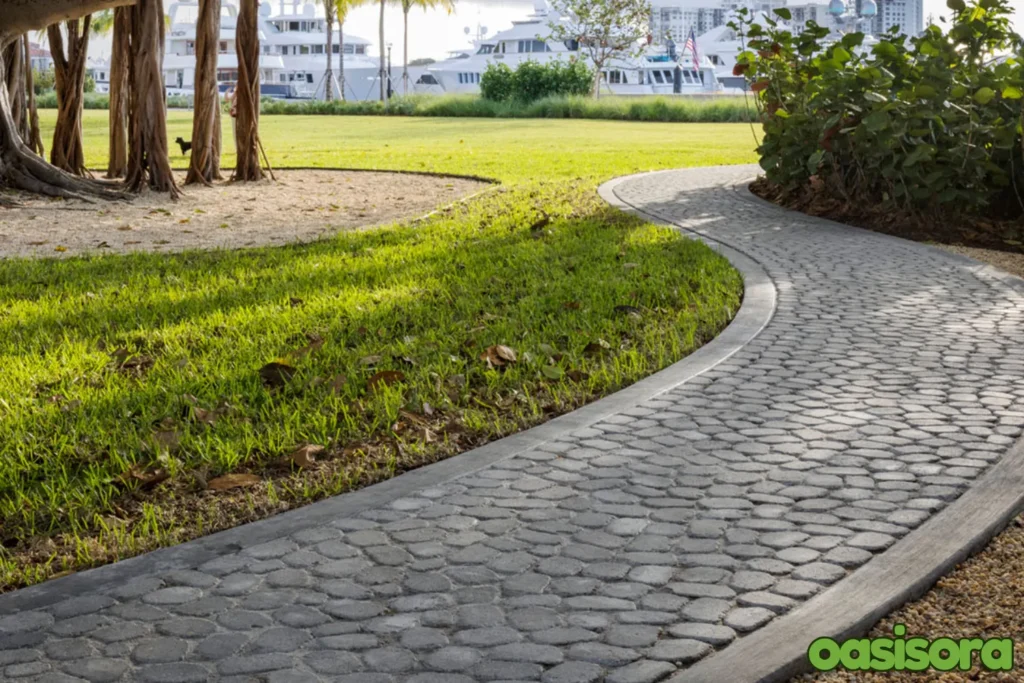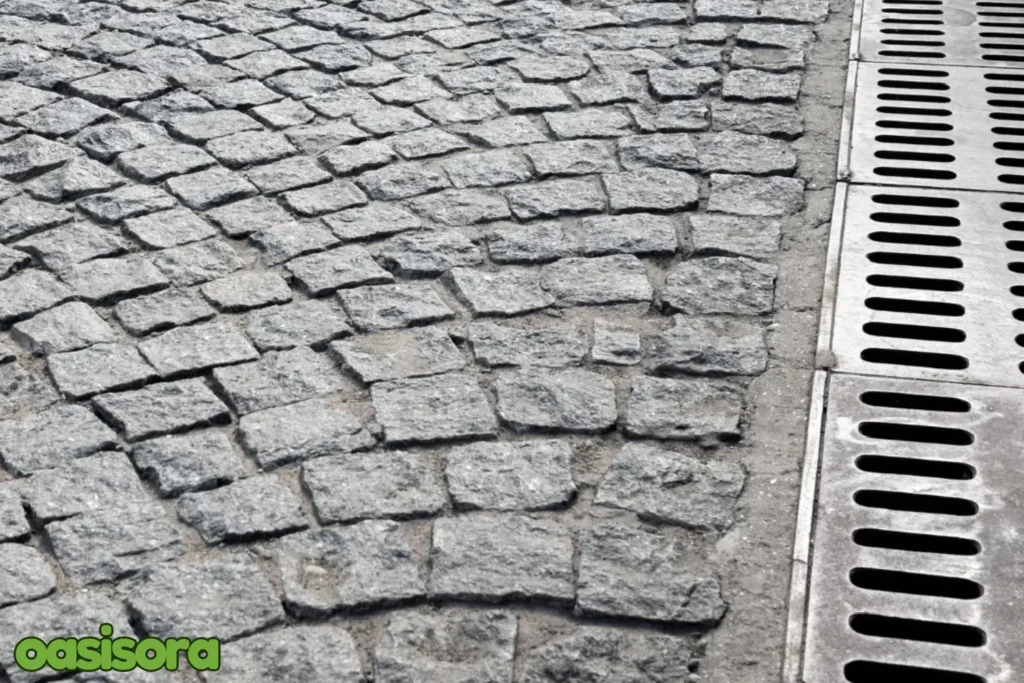
The practicality and sustainability of cobblestone driveways make them a perfect choice for real and environmental friendliness solutions for your landscape.
Such pathways are extremely beneficial for long term usage, possessing a classic appearance, sturdiness, and can tolerate severe weather.
Their simple maintenance and nontoxic natural materials are the basis of their longevity. For homeowners looking to make a secure decision for their property, here we cover the several benefits, disadvantages of cobblestone driveways, offering details on their construction, and value over time.
What is Cobblestone?

Cobblestone curved driveway
Cobblestone is a finely rounded stone that has previously been used for ages in building roadways and creative sidewalks. Granite, basalt, or limestone are the main substances present in this amazing stone.
In the past, they were used in primitive streets, also having current significance for their strength and beauty, particularly in luxury residential and historic buildings, making them more valuable and attractive for you.
Cobblestones with a long lifespan, and natural drainage qualities, are more environmentally friendly than other concrete like pavement options.
Concrete roadways are cost effective initially, they may require greater maintenance over time, and fail to provide the same timeless elegance and durability as cobblestone. For more flexible and cost-effective surface options, many homeowners also explore landscaping with decomposed granite.
The Practicality of Cobblestone Driveways

Cobblestone pathway with greenery
Prefer cobblestone driveways as they are ideal for long-term use due to their strength and resilience to severe weather. Their distinct pattern creates a natural system of drainage, which decreases soil erosion and puddles.
- Durability and Strength
These stone paved driveways are widely praised for their amazing strength and durability, dealing with frequent use along with heavy loads with ease. Despite hefty traffic or the combined weight of cars, the integrated stones promote stability by limiting shifting or cracking.
The lifespan of cobblestone is considerably higher than that of other substances as it can last for 50 years or more with minor care.
On the other hand, asphalt with moderate maintenance generally lasts 15 to 20 years, and concrete roads about 30 years, posing the risk of cracking.
Despite its higher initial costs, it is an exceptionally affordable choice due to its usefulness and minimal management for long-term uses.
- Aesthetic Appeal
Besides the practicality and sustainability of cobblestone driveways, the stylish and classy appearance of these paths may significantly increase the entire look of your landscape.
It is an effective option for anyone looking for reliable beauty because of its natural, rustic charm, which provides elegance and quality to any spot.
They are made from different kinds of materials like sleek granite and limestone. Herringbone patterns, circular, and random layouts are some amazing designs available in unique colors for cobblestones that builders can implement to customize their driveways and make them fit with their yard’s overall design.
- Permeability and Drainage

Driveway with overflow water sink
The intervals between these driveways efficiently handle overflow by permitting water to sink through the soil instead of storing it on the surface. This characteristic lowers the chance of flooding by allowing efficient water drainage, especially during heavy rainfall periods.
By reducing the demand for expensive drainage channels, cobblestones serve greatly to stormwater management.
They are an environmentally friendly alternative for homeowners concerned about their environmental impact because of their ability to contribute to groundwater recharge and prevent runoff from the earth’s surface.
- Low Maintenance
As these natural stone driveways are resistant to everyday wear and tear, they save a lot of your time and money required for maintenance. Because of their adaptability, they tolerate severe weather and high traffic levels without experiencing major harm.
Simple periodic care usually consists of cleaning spots to dispose of trash and resetting stones when they break or loosen. They are a popular choice for individuals seeking lasting beauty with little attention because of their low servicing needs.
- Seasonal Adaptability
Due to the practicality and sustainability of cobblestone driveways, they thrive well in all weather conditions, including extreme hot and cold temperatures.
They are ideal for areas with severe winters due to their fundamental durability, which enables them to tolerate freeze-thaw cycles without breaking.
Long-term dependability and efficiency are offered in all climates by the stones’ tendency to expand and contract in reaction to temperature changes, letting them remain secure and functional throughout the year.
Cons of Cobblestone Driveways

Uneven surface (Cons) of Cobblestone driveway
Constructing a cobblestone driveway can turn out expensive and laborious. Also, their uneven surface may make moving uncomfortable while creating problems for cars that have less ground clearance. Let’s overview its few limitations.
- Initial Cost
Unlike traditional concrete or asphalt pathways, cobblestone driveways are generally more costly. The particular kind of stone, the work level required, and the complexities of the design are some aspects that can affect the price.
Cobblestones may cost extra upfront, but in the future, their everlasting attractiveness and robustness may make the expense valuable.
- Installation Complexity
Because it takes some patience and expertise to lay each stone correctly, cobblestone driveways must be installed by professionals.
To achieve stability while minimizing movement over time, proper planning is essential. A well-designed base with proper evaluation, settlement, and drain is crucial for the sake of the driveway’s endurance and reliability, while preventing future maintenance problems.
- Uneven Surface and Accessibility
Apart from practicality and sustainability of cobblestone driveways, they can affect availability by generating uneven surfaces that are exhausting for wheelchairs, walkers, and strollers to cross.
Anybody experiencing mobility problems, comprising youngsters and adults, might have concerns about little vibrations and noises.
After selecting cobblestones, it’s significant to take these elements into account because uneven surfaces might require extra adjustments for convenience as well as security.
- Snow and Ice Removal
Rustic stone driveways can be even harder to clear of snow and ice with the uneven texture and spaces between the stones.
As time passes, strong chemicals like salt may negatively impact the stones, and shoveling or utilizing a snow blower can prove less effective. To safeguard the driveway, it is necessary to choose simple approaches, such as applying sand or a plastic shovel.
Sustainability of Cobblestone Driveways

Sustainable Cobblestone Driveway
Made of persistent, natural materials requiring minor upkeep over time, cobblestones are remarkably sustainable. Let’s learn about how their green features can help the natural world and your real estate.
- Environmental Impact
Cobble driveways have negligible environmental effects since they consist of natural, reusable stones like granite and basalt requiring no complex processing.
They are recyclable and emit few harmful particles during production, unlike concrete or asphalt. By increasing water absorption and preventing runoff, their long-term reliability and permeability further offer you a healthy environment.
- Longevity and Lifespan
Such driveways are known for their resilient behavior and require fewer repairs with time. By deciding upon cobblestone instead of asphalt or concrete, landowners can prevent the waste they generate from turning up in landfills.
- Heat Island Reduction
Cobblestones trap less heat than asphalt or concrete, thus assist in reducing the urban heat island effect. They avoid holding heat because they are porous, letting water and air pass through.
As a result, urban regions get cooler, benefiting outdoor comfort and eliminating the demand for artificial cooling, making it favorable for the environment and energy conservation.
- Reusability and Recycling
As cobblestones are highly reusable, waste can be significantly minimized by using leftover stones from old driveways to construct new structures.
The reusable feature of cobblestones, leading to environmentally sound building and designing techniques, along with eliminating the need for fresh construction supplies, guarantees low waste storage.
- Low Energy Consumption in Production
Creating cobblestone driveways generally involves human labor instead of relying on heavy machinery. As an outcome, less energy is consumed during construction.
In contrast to man-made alternatives like concrete, cobblestones use fewer resources to produce as they are made from natural stone, so they go through the least processing.
Furthermore, implementing these permeable stones saves energy consumption by reducing the need for sophisticated stormwater management systems.
- Carbon Footprint
Limiting the distance necessary to transport the stones, and using materials that are readily accessible, such as cobblestone, assists in lowering emissions caused by transportation.
In comparison with alternative paving substances like concrete or asphalt, which often involve higher levels of energy production and long travel paths, this greatly lowers the carbon footprint.
Cost of a Cobblestone Driveway
The worth of a cobblestone driveway satisfies all resources, labor, and periodic management. Despite originally costing more than synthetic materials, such pathways are an excellent investment because they have durability and perseverance.
These entryways are easy to manage, and can last for years if installed appropriately, resulting in lower long-term maintenance expenses.
It’s an effective strategy, so seek estimates from multiple contractors while considering the practicality and sustainability of cobblestone driveways to balance the expenditures.
Designing Your Cobblestone Driveway

Cobblestone driveway design inspiration
Through the practicality and sustainability of cobblestone driveways and their stunning setup, you can produce a distinctive and classic look that fits seamlessly with the architectural structure of your house.
- Patterns and Layout
Herringbone, basketweave, and random placement are trendy cobblestone layouts, all of which feature a unique, distinctive look. While basketweave presents an increasingly inflexible shape, herringbone results in an everlasting, sharpened impression.
You can create a driveway that combines with the overall style of the site by modifying the concept to fit with the interior decor and landscape.
- Choosing the Right Cobblestone Size
Cobblestone size has a great role in a driveway’s architectural looks and functionality. While smaller rocks provide a deeper and more consistent appearance, bigger ones generate a strong, traditional effect.
Focus on aspects like the amount of traffic, charm, and the required operating smoothness while adopting cobblestone dimensions.
- Complementary Features
A harmonious and trendy environment is possible by merging cobblestone roads with other external features including patios, paths, and garden walkways.
The general aesthetic of your space increases by consistent placement of cobblestones in different spots, and the materials’ adaptability supports innovative patterns and effortless changes within outdoor areas.
The whole structure acquires beauty and effectiveness from this layout approach.
Conclusion
In short, the practicality and sustainability of cobblestone driveways make them an outstanding choice for homeowners.
Their enduring qualities guarantee reliable effectiveness, and the natural materials support environmental sustainability by requiring less energy and leaving fewer waste streams. Cobblestones represent more powerful drainage, thereby decreasing the risk of floods.
The use of such natural elements and their reusability characteristics are eco-friendly solutions and a useful investment for a long-term practicality.
To ensure a secure combination of permanency, style, and functionality, cobblestone driveways are an appropriate choice due to their easy upkeep and classical elegance.
FAQs
How long do cobblestone driveways last typically?
These driveways are strong and dependable so they can last for a minimum of 50 years with appropriate care.
Does cobblestone work appropriately in extreme weather regions?
As it can deal with high temperatures and freeze-thaw cycles without collapse, cobblestone works well for areas facing severe weather conditions.
Is DIY installation sufficient for cobblestone driveways, or is professional help necessary?
Although DIY installation is feasible, professional help is encouraged for precise stone placement along with thorough base preparation.
Suggest any eco-friendly substitutes for such stone?
More environmentally conscious substitutes for cobblestone comprise gravel, permeable paving stone, and recycled products like reused brick.
